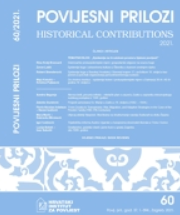Epidemije kuge i zdravstvena kultura u Šibeniku u kasnom srednjem vijeku
The Plague Epidemics and the Sanitation Culture in Šibenik during the Late Middle Ages
Author(s): Zoran LadićSubject(s): Local History / Microhistory, Government/Political systems, Security and defense, Health and medicine and law, 13th to 14th Centuries, 15th Century
Published by: Hrvatski institut za povijest
Keywords: Dalmatia; Šibenik; Late Middle Ages; epidemics; health;
Summary/Abstract: In this article, the author examines the appearance of plague epidemics in the Dalmatian commune of Šibenik in the late medieval period, from the Black Death in 1348 until the end of the fifteenth century. The analysis is based on the research of data from Šibenik’s statutory law – statutory decrees and later added novels (reformationes) – of the diplomatic relations and commissions between the Venetian central authorities and the commune of Šibenik, and of various communal published and unpublished sources. Yet, the most valuable data are the communal notary records, primarily last wills and inventories of goods, which enable the punctual examination of places where the plague epidemics raged in certain periods (villages, city, islands in the district). Last wills and inventories of goods are extremely valuable in establishing the beginning and ending of plague epidemics because they contain data on the dates of recording the wills, the death of testators, and the composing of inventories. These sources also allow us to examine the duration of plague epidemics. Thus, we know that some plague epidemics in the commune of Šibenik lasted for several months while others raged for one or even two years. The research has shown that the outbreaks of plague epidemics occurred much more frequently than has been hitherto assumed, either in the city of Šibenik or in the villages of its densely populated district. In any case, the research has shown that plague epidemic in the fifteenth-century commune of Šibenik appeared much more frequent than it has been considered until now. The author also discusses the health protection measures undertaken by the central Venetian and communal Šibenik authorities to prevent the spreading of plague epidemics, particularly within the city walls. The sources, especially last wills and inventories of goods, but also some other types of notary deeds, statutory law and its novels, as well as the ducales issued by the central Venetian government and decrees issued by the communal authorities, clearly show that the commune of Šibenik implemented the same healthy, medical, and hygiene measures available at the time as other European urban-rural societies. Deceased persons, as well as members of their nuclear families, were immediately put into isolation outside the city walls and situated in empty houses in the surrounding villages. The communal authorities, patricians, rich merchants, and members of clergy likewise found refugee in villages within the communal district or in their houses and palaces on communal islands.
Journal: Povijesni prilozi
- Issue Year: 2021
- Issue No: 60
- Page Range: 39-75
- Page Count: 37
- Language: Croatian

